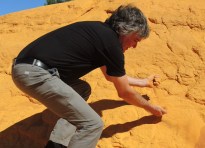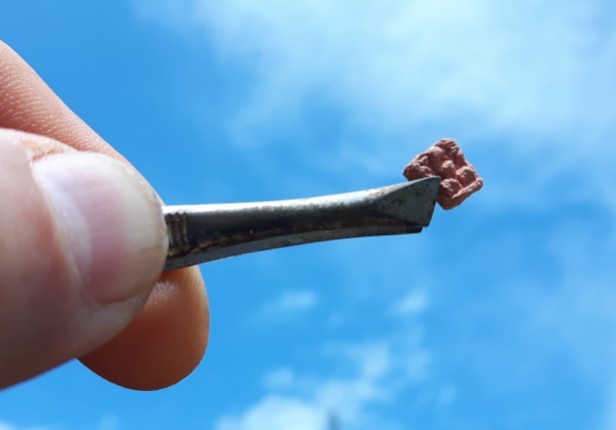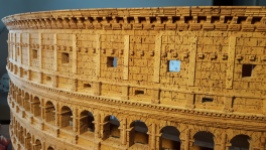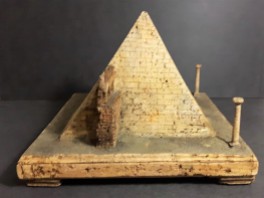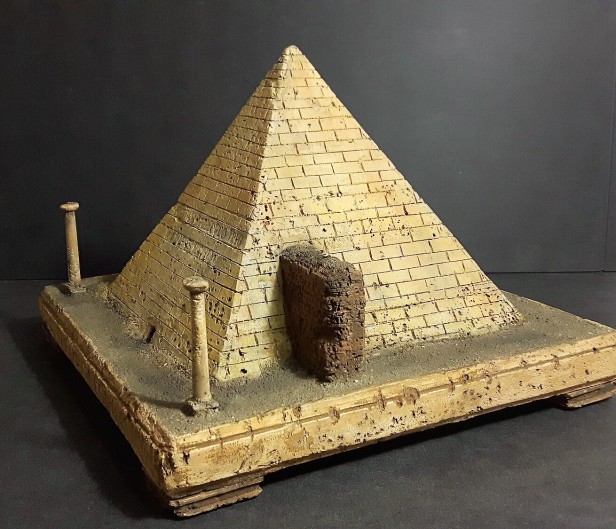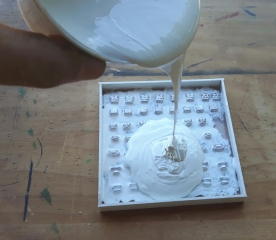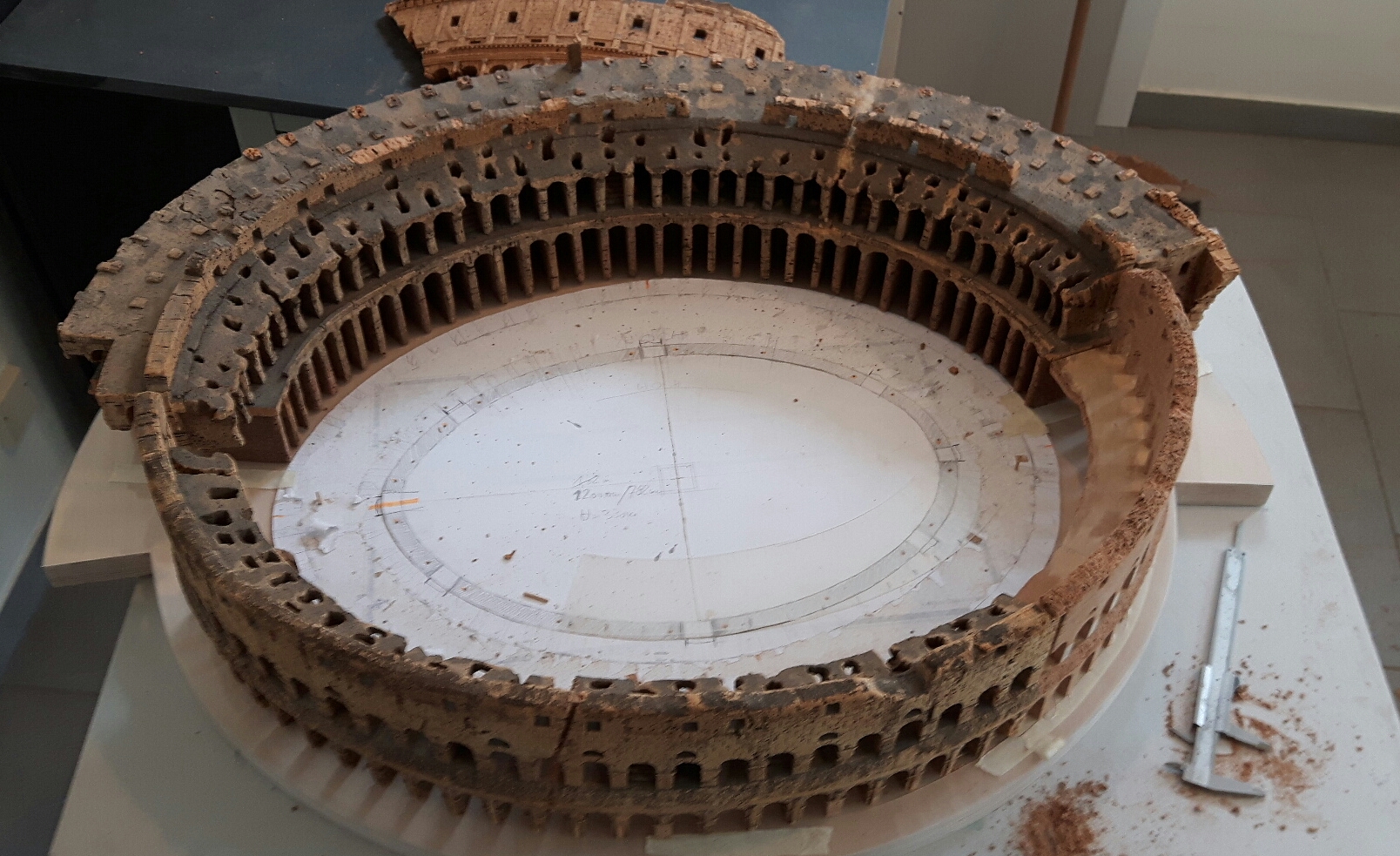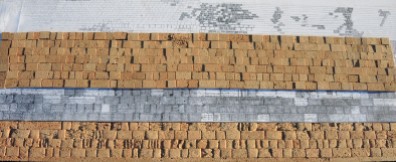
Korkmodell


ETRUSCAN CULTURE
A new cork model represents an Etruscan burial chamber carved in sandstone. While Dieter constructs the model in longitudinal section, Malgorzata concentrates on painting the artistic frescoes. They later form the heart of the model – an emotional insight into a forgotten time and culture.



BIRTHDAY
A few temples have already seen the light of day under the hands of Dieter and Malgorzata. However, they are always unique pieces with their own personality. The work is always a great challenge and leads to new craft experiences. The object ( POSEIDON – TEMPLE IN PAESTUM scale 1:100) still needs some additions, but today it leaves the studio for the first time and is kissed by the sun in Malgorzata’s hands.






HOT SPOT
THE COLOSSEUM was certainly once one of the bloodiest spots in the world – we all know its history. However, its ruin gives us the opportunity to change our perspective and think about different aspects.
Dieter and Malgorzata decided to create a new cork model of this unique monument and integrate all their knowledge into the object, with the desire to offer the audience a wide emotional scope for reflection. Let’s see where the journey goes…




LIVING FOR BEAUTY
Cork model of the Temple of Athena in Paestum on display in a private residence in Las Vegas


RESPECT AND JOY FOR EVERYONE
Shadow play made in Auschwitz with a cork model of the great pyramid and a children’s toy

A NEW MUSEUM
is open to the public. 14 large cork models by Dieter and Malgorzata Cöllen can be seen in the architecture cabinet of the PASSAU STATE LIBRARY





BACK ON STAGE
After a long time in the darkness of the archives, the cork model of the Capitol Temple can now be seen in Cologne in the Church of ST. MARY IN THE CAPITOL and shows the interesting architectural history of this place.




THE GATES ARE OPEN
The cork model of the Pantheon has arrived at the LINDENAU – MUSEUM and is open to the public in the wonderful ALTENBURG CASTLE…








SALVE ROMA
The cork model of the Pantheon in Rome will be presented to the public in the LINDENAU MUSEUM / ALTEBURG in the exhibition „SALVE ROMA“ from October 8th, 2023 to July 28th, 2024.

BEAUTY UNDER CONSTRUCTION
Corkmodel of the Pantheon in Rome, scale 1:100 by Dieter Cöllen and Malgorzata Lagan

A GREAT HONOR
Today Dieter and Malgorzata had the honor of being guests of PROF. DR. HERBERT BLOMSTEDT in Lucerne. As an admirer and collector of their cork models, they were allowed to take a little journey through his eventful life and benefited from his warmth and immense knowledge. Now it’s summer break, but soon he’ll be touring again and conducting the most famous orchestras. Thank you from our hearts and good luck..

THE PANTHEON – CORK MODELL IN PROGRESS
Perfection demands respect – in it´s contemplation as well as in it´s reflection. The work on the cork model is entering now into it´s most important phase – the modeling of the small details…





Architectural Masterpieces in Cork
The cork models of the three temples at Paestum in front of the engravings of Piranesi at BURDEN – Long Island, New York

Photo: Rainer Mader

Photos: Burden

GOVANNI BATTISTA PIRANESI
and cork models by Dieter Cöllen and Malgorzata Lagan at AHLERS PRO ARTE with an excellent lecture by Dr. Phil.Vera Lüpkes VIDEO






Fotos: Dieter Cöllen, FichterArt

ARCHITECTURE CABINET
After completing the cork model of the , ARCH OF DRUSUS Dieter and Malgorzata integrated it into the architecture cabinet in the old Jesuit library in Passau – In good company…








ON THE ROAD
Dieter and Malgorzata are starting a new project – the Arch of Drusus in Rome. It was part of the Roman aqueduct to supply the BATHS OF CARACALLA. Work begins with the construction of the VIA APPIA, which the arch crosses…

The planning was kindly supported by DR. HEINZ-JÜRGEN BESTE / DAI Rome. Literature: VALERIA DI COLA – L´ARCO DI DRUSO SULLA VIA APPIA.


THANK YOU CAMBRIDGE
At DOWNING COLLEGE Dieter and Malgorzata spent an unforgettable time together with wonderful people from the university and a very interested audience at their seminar – thank you Cambridge!



DIETER AND MALGORZATA IN CAMBRIDGE
Dieter and Malgorzata are invited to talk about their work in Cambridge, Downing College https://www.eventbrite.co.uk/e/the-architect-of-ruins-with-atelier-dieter-collen-tickets-418020068277

FURTHER STEPS
Work on the Pantheon continues. Here Dieter and Malgorzata assemble the columns of the hall…






DOWNING COLLEGE
Watch here the seminars at Downing College and follow DIETER AND MALGORZATA to Cambridge

JUST COME TO CAMBRIDGE
Dieter and Malgorzata are very honoured to have been invited by DOWNING COLLEGE / CAMBRIDGE to report on their work – JUST VISIT

OPENING SOON
Dieter and Malgorzata have been building large cork models for the architektur cabinet in Passau for several years. With many other objects, they will soon be shown to the public in a wonderful ambience.
The architectural cabinet is part of the Historic Jesuits Library at the State Library of Passau. With the perfectly preserved historic rococo library hall as a starting point the Historic Jesuits Library tries to reconstruct the Jesuits Library in Passau. Jesuitic presence in the city goes back to the year 1612, when the Jesuits founded their institute for higher education in Passau. Also part of the Historic Jesuits Library is a WUNDERKAMMER. Opened in the year 2015 it uses old exhibits still present in the collections of the library as well as permanent loans from important collections of the Bavarian State. The Jesuits had a keen interest in architectural history, which is reflected by a remarkable collection of important literature on the subject. Part of this collection is also presented in the architectural cabinet.

CULTURAL HERITAGE
Dieter as a guest in a scientific stage discussion in the RAUTENSTRAUCH-JOEST-MUSEUM in Cologne about the cultural heritage of Syria and its importance in the future…


THE ART OF RECONSTRUCTION
is the title of a workshop by Dieter and Malgorzata in the RAUTENSTRAUCH – JOEST – MUSEUM in Cologne. Using the example of the Temple of Bel in Palmyra, children will try to recreate the porticus of the temple from the remains of the destruction (here: cork fragments) and make the personal experience that destruction is easier to do than reconstruction. Dieter and Malgorzata give the children complete freedom in their work. Ibrahim and Rosslin from Syria are also there. They had to leave their country from violence, and now they feel like „ambassadors“ between cultures… Many thanks to everyone – we adults also learned a lot!!!









SYRIEN – GEGEN DAS VERGESSEN
The RAUTENSTRAUCH – JOEST – MUSEUM in Cologne is showing a unique exhibition on the great loss of Syrian culture in times of peace. The curator JABBAR ABDULLAH has spared no effort in bringing together artefacts, films and photos that have never been shown before. Dieter’s cork model of the TEMPLE OF BEL can also be seen here. The model was started a few days after its violent destruction in 2015 and completed a year later.





AGAINST DESTRUCTION
As we know, targeted activism is the best medicine for mental paralysis brought on by human stupidity… Inspired by their trip to Rome, Dieter and Malgorzata work diligently on the construction of the Pantheon. As the video shows, the shell of the model is almost complete. Fly with us and maybe enjoy the great architecture of the old masters, which can still bring us closer to the beauty of human creativity even after 2000 years…

ROME -THE BEAUTY
Dieter and Malgorzata visit Rome to study the details of the Pantheon for the construction of the model. Of course they also enjoy spring and are inspired by the charm of this unique city…







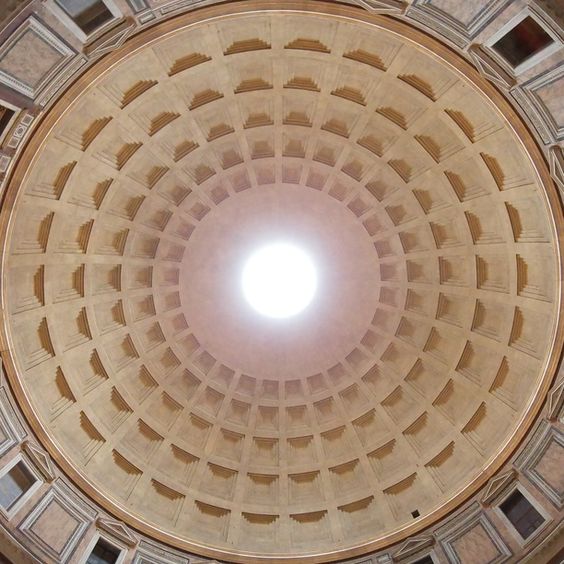
THE DOME
The dome of the Pantheon, with an inner diameter of 43.30 m was the largest of its kind for a long time, built with Roman concrete OPUS CAEMENTICIUM Its coffered structure posed a great challenge for Dieter and Malgorzata. First they make a negative mold, which is then filled with 7 layers of cork. The individual segments are then joined together to form the imposing dome.







THE FLOOR
The floor of the Pantheon, which corresponds to the diameter of the dome (43.3m), is inlaid with a pattern of large squares and circles in PORPHYRY, gray GRANITE and Gialla Antico, a coveted yellow marble from SIMITTHU, framed by strips of Pavonanzetto. In order to reproduce this valuable material realistically, the cork base of the model is first coated with chalk primer and later sanded. Then Dieter and Malgorzata apply the intricate pattern in many layers of paint to get the desired effect…




THE PANTHEON IN ROME
For most people, the mere memory of visiting the PANTHEON in Rome arouses great emotional feelings, combined with a longing to return to this magical place. So why not bring the object to the viewer?! Dieter and Malgorzata will face this great challenge. They plan over a year to produce a cork model scale 1:50, which should also show the complete interior with its elaborate equipment. Let’s watch the two of them at work and follow the single steps of this forgotten craft until completion…




BACK TO THE FUTURE
A new designed building by the Berlin studio KAHLFELD ARCHITECTS is the base for the next cork model from Dieter and Malgorzata. The task is to turn the time further into the future and to capture the imaginary decay in maybe 2000 years – an interesting perspective from two points of view …






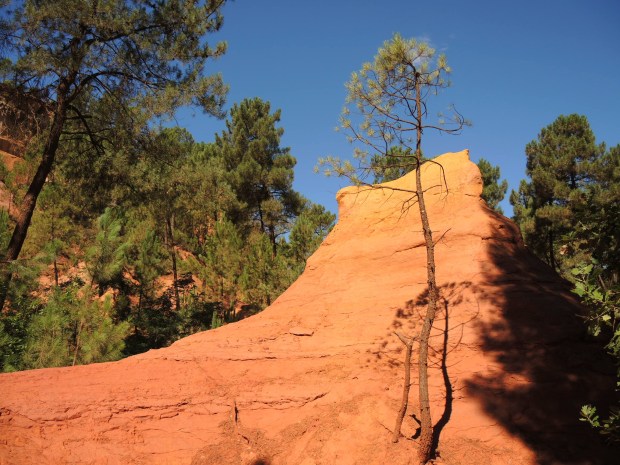
COLOUR
Malgorzata uses natural pigments from the ROUSSILLON in France, which can be found in the landscape there, for the surface of the model. This work takes a lot of time because the paint is applied in several layers in order to achieve the desired result. After that, the pillars must be fixed. A final „make-up“ follows to highlight the contours …




THE TIME OF PHARAOHS
Dieter’s cork model of the Great Pyramid has safely crossed the Atlantic … It will be on view in an exhibition at the Utah-Museum / Salt Lake City from May 20th, 2020 – January 2nd, 2021.
Exhibition title: EGYPT THE TIME OF PHARAOHS
“Let´s hit the dusty trail!”…


LIVING FOR BEAUTY
A new project by BEN PENTREATH poses a major challenge for Dieter and Malgorzata. They have to create an object of his design that touches the viewer’s emotions and shows that real beauty never dies. Cork seems to be the right material for this purpose. Let’s watch them at work …

PICTURE SHOW
Today Dieter and Malgorzata would like to invite you to a picture show of their cork models – have fun!
CORK MODELS OF ANCIENT MONUMENTS

THE PHAROS OF ALEXANDRIA
The cork model of the Pharos of Alexandria was built by Dieter in 2015 for an exhibition in the Kunsthalle Leoben / Austria, with the scientific support of Prof. Dr. Michael Pfrommer . Now an exhibition team is working on a new presentation. We are all very excited and will report on the development of the efforts on the blog …



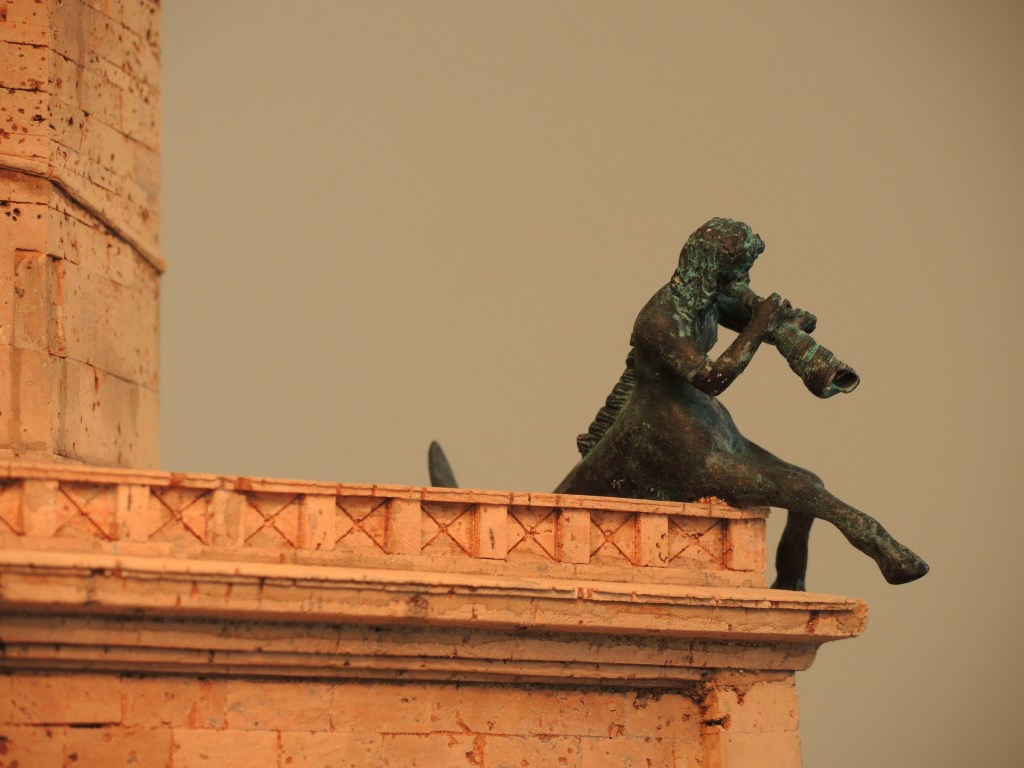









ARCHITECT OF RUINS
The current book with the cork models by Dieter Cöllen from the JEFF KLOTZ VERLAG in German and English
Why do ruins never cease to provide refreshing shade, despite of their turbulent past?
This question occupied my mind from a young age, when I was a boy searching for lizards in the cracks of ruinous walls. Fortunately, to this very day I did not receive an answer – instead, it inspired my curiosity, humbleness and dreams as well as the wish to erect a monument for these patient witnesses of deterioration.
“Quercus suber” (CORK OAK) made the realisation of these dreams literally “easy”. All the cracks, fractions and damages of stone are already inherent in the cork´s bark and invited me to uncover them.
It is a work against all reasons and custom, only focused on preserving the most authentic picture of ageing; to acquire and transmit a rare monument of undisturbed awe – because in the blink of an eye, it´s like nothing ever happened.

TIVOLI
The Vesta Temple in Tivoli was a must for travelers on the „Grand Tour“ in the 18th century. It was, and still is, a symbol of Romanticism in painting and architecture. Dieter and Malgorzata have tried to capture this effect in a new cork model.

OPENING UP THE SOANE
The Sir John Soane’s Museum in London is one of the most beautiful and interesting museums in the world. Soane collected many cork models during his lifetime, which can still be admired today in a wonderful ambience. Dieter Cöllen had the honor of completing and restoring the famous „model stand“. Together with his friend Hannes Fischer and many other specialists he worked on completing Soane’s dream and living space. Here Dieter invites you to follow him at work in a VIDEO https://www.soane.org/collections/videos/creating-cork-architectural-model

BIRTHDAY
After all parts have been fixed in place and the pigment layers have been applied, Dieter and Malgorzata photograph the cork model in optimal daylight. The southern French evening sun, which brings the object to life in warm tones, is ideal for this purpose …


HEAVENS GATE
The cella is the sanctuary of the temple and was only accessible to the priests through a more than 6m high bronze portal. Dieter and Malgorzata try to reproduce the effect of this monumental entrance as precisely as possible. They do the same with the roof tiles…

STRAIGHT UP
The pillars of the temple are the supporting elements of its architecture. It takes a lot of time and precision to manufacture. Dieter and Malgorzata therefore work with the greatest care and patience…



WORKING OPEN AIR
Dieter and Malgorzata work on the columns in the warm French daylight of the Cahors region. A very meditative work …
Meditative work

MAISON CARRÉE UNDER CONSTRUCTION
https://de.wikipedia.org/wiki/Maison_Carr%C3%A9e
A new project is on the way to be realized. After Dieter has visited thewonderfully restored temple in Nimes, he starts building the cork model according to precise plans of the famous monument.

LIVING FOR BEAUTY
A new exhibit comes along at the https://museum-schloss-brake.de/sonderausstellung/ WESERRENAISSANCE-MUSEUM Schloss Brake / Lemgo, showing cork models of Dieter Cöllen beside the famous work of GIOVANNI BATTISTA PIRANESI

LIKE A ROCK
The Pont du Gard is founded on solid rock. To visualize this perfectly in the model Dieter uses 9 years grown cork bark from selected oaks in Portugal. After gluing the cork 
 he will treat the material like a sculpture to imitate the beauty of nature as best as possible…
he will treat the material like a sculpture to imitate the beauty of nature as best as possible…

BRIDGE UNDER CONSTRUCTION
Like the ancient builders Dieter constructs the 52 arches of the Pont du Gard „stone by stone“…



NEW PROJECT: PONT DU GARD
After completing the Coliseum, Dieter focuses his attention on an extraordinary Roman monument – the aqueduct PONT DU GARD north of Nimes. This cork model with a length of 2.75 m will be unique worldwide…



ULTIMATELY AT HOME
Together with other cork models, the Colosseum finaly finds its place in the STATE LIBRARY PASSAU

PLEASURE AND SADNESS

THE FINAL STEPS

CAPITALS AND COLOURS
After fixing the capitals Dieter and Malgorzata are going to mix the natural pigments they got from Roussillon
in south of France. This technique was born in the 18th century and gives the cork a warm and smooth surface.

CAPITALS

NORTHERN VISITORS
Yesterday Dieter had charming guests from Finland. The famous TV moderator ELLA KANNINEN and her team visited his “small kitchen” to talk about cork models and filmed Dieter at work.
We all are waiting now for the result that will be shown at the beginning of next year – thank you so much…

THE INNER STRUCTURES
The inner part of the Colosseum has cosmic dimensions. During the next days Dieter will build all the constructions for the audience tribunes that made the monument once to the biggest stadium at its time…

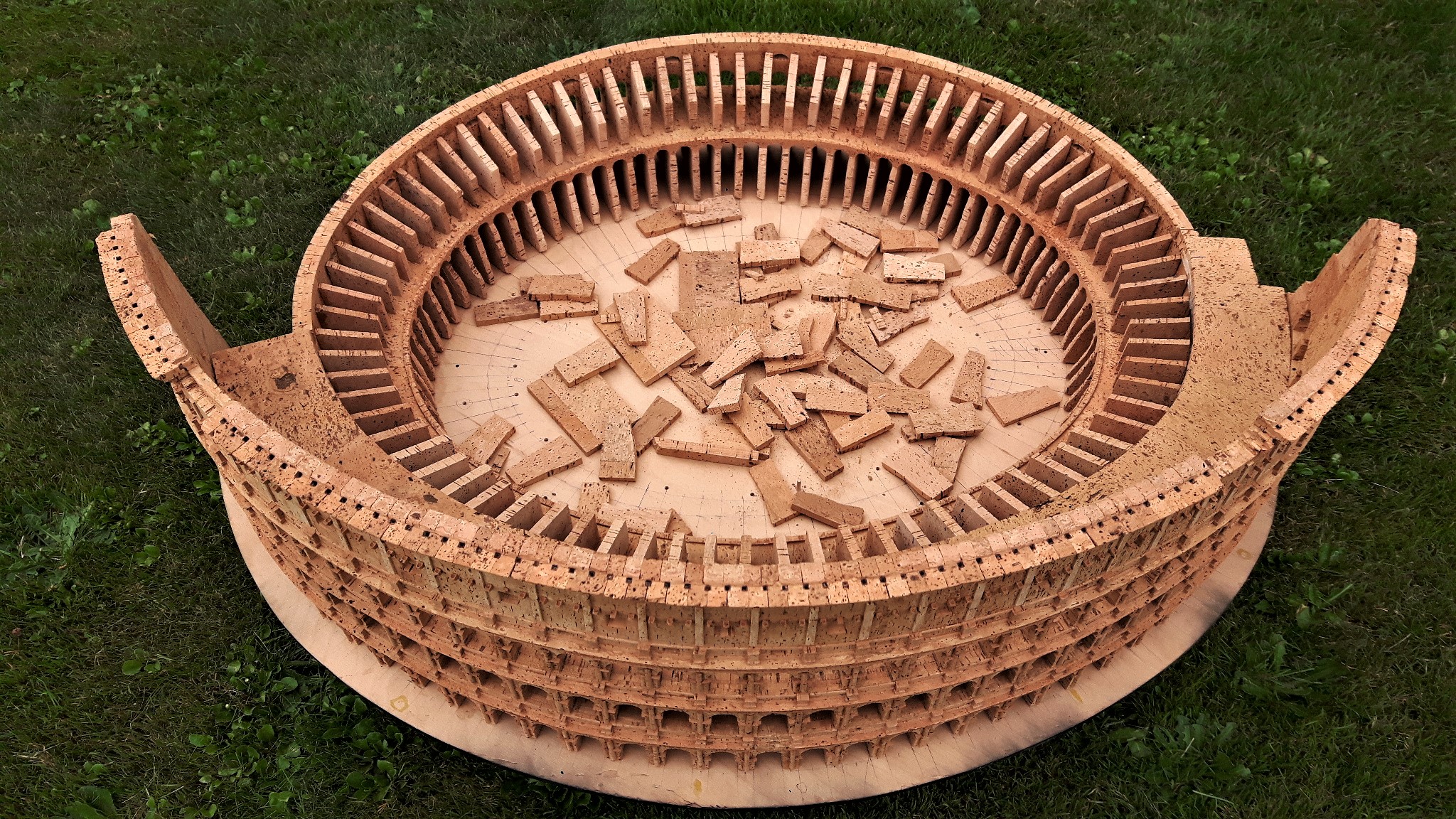


SHADE ON THE AUDIENCE
Now the upper section of the facade is nearly finished including the brackets which support the wooden poles for the shading construction. We don’t know much about that, because all that disappeared during the centuries. Watch here a video about an idea how the VELARIUM could have worked.

PROFILING

STONES AND STRUCTURES

350 ARCHES

LIFESTYLE
Imagine yourself – sitting there on a Sunday morning in company with some friends having this spectacular view of the Colosseum. Some birds are singing in the trees interrupted by the roaring noise of more than 50 000 people hypnotized by a bloody fight behind that beautiful facade…

SHAPING THE OVAL

THE „NEW“ COLOSSEUM
Since Luigi Carotti built the last cork model of the Colosseum in 1840 nobody toughed that theme again. Today Dieter Cöllen decided to create another object of this incredible monument. He calls his project “Homage á Luigi Carotti” and wants to discover if his artwork can exist beside the quality of the ancient master. The audience is invited to decide…
After getting the plans Dieter starts first to form the oval walls of the Colosseum. Here you can see him working on that basic part. With the assistance of Malgorzata he builds the support structures…
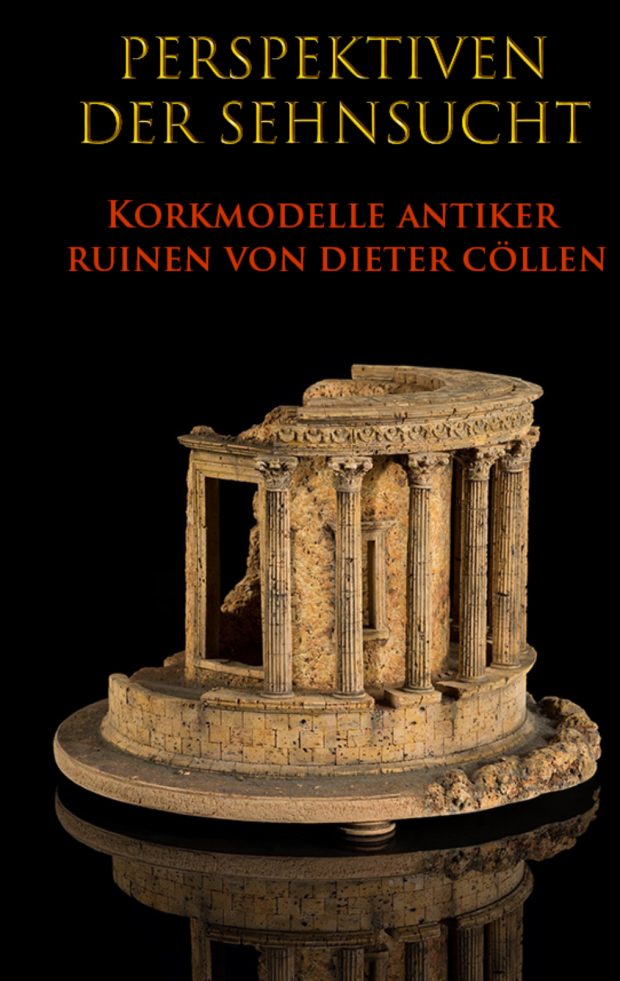
NEW EXHIBIT

COLOUR AND VERNICE

SAND – GLUE – PATINA
The old masters often used sand for the ground but over the centuries it disappeared on different parts. Dieter uses river sand and glue for the restoration. After the drying process he applies patina to make the repaired areas invisible.

TWO COLUMNS

A SOLID BASE
i
in the 18th century most of the cork models where manufactured in a hurry due to high demand. Especially the wooden base was often made very carelessly. For that reason many old cork models are in very bad condition today. For Dieter, a solid base is therefore the top priority. After this work is done he begins to restore the cork frame of the object…

RESTORING A BAD TREATED BEAUTY
Dieter´s next restoring project is an ancient cork model of the pyramid of Cestius / Rome. Probably it was manufactured in the studio of Carl May. This object was once a well loved “Souvenir” of the Grand Tour. This model went through several hands and was badly treated during the centuries.
Another new challenge for Dieter…

THE FINAL TOUGH
Back from the Provence Dieter uses the natural pigments he got to set warm “late afternoon sunlight” on the surface of the Colosseum. This very important part of the work appeals to our emotions and is the final tough of every restoration…

WEDDING DAY…
work on the Colosseum reaches a significant stage. The monument has to be “married” with its base. 150 points must be glued at the same time connected with 13 wooden dowels.
This demanding action can not be done by one alone. Dieter has support from his friends Stefan and Gerd. Together they achieve a perfect result. This effort has the purpose of creating an unbreakable connection that will last for the next 300 years…










LIVING FOR BEAUTY…
Two beautiful people and their PIRANESEUM

SHADE ON THE AUDIENCE…
Now the upper section of the facade is nearly finished including the brackets which support the wooden poles for the shading construction. We don’t know much about that, because all that disappeared during the centuries. Watch here a video about an idea how the VELARIUM could have worked.

COLUMNS
After the capitals where dipped in different liquids, the elements are glued on the facade. Now the proportions are visible again as well as the order of the columns…



CLAY AND STUFF…
After the drying process of the silicon Dieter prepares the “filling” according to an old recipe. The main ingredient is powdered clay but also other components are necessary to get the best result.
The most important is to get the bubbles out of the liquid. After the drying every single piece must be taken out of the mold carefully. In further steps they must be cleaned with a rotating brush and later coloured with natural pigments…





CAPITALS
On the facade of the Colosseum we find Doric, Ionic and Corinthian columns. Carotti modeled them very accurately in this small scale. But most of them are lost ore crumbled to dust. To make the original beauty visible again, Dieter first produces silicon moulds of the best pieces….
After the drying process he will be able to pour the negative in further stepps…

LIFESTYLE
Imagine yourself – sitting there on a Sunday morning in company with some friends having this spectacular view of the Colosseum. Some birds are singing in the trees interrupted by the roaring noise of more than 50 000 people hypnotized by a bloody fight behind that beautiful facade…

Dieter Cöllen – A PASSION FOR CORK

THE WALL
For many years Carottis Colosseum was destroyed and nothing more than a ruined ruin. Now for the first time the outer wall is rebuilt. There is still a lot of restoring work to do but we can already imagine the beauty of this monument. A beauty that is deceptive, because this wall hid one of the most bloodiest spots in the world…

THE OUTER WALL
Most of the pillars of the outer wall are lost, broken or not in an upright position. Each of them needs to be restored or rebuilt. A constructed “horizon” helps Dieter with the assembly…


JUST A SOUVENIR?…
In the 18th century even the Carotti´s Cork model of the Colosseum found its way across the Alps in order to teach people about unknown culture and architecture. To get to those unknown historical spots the first tourists spent years for treveling but when they came back home their intellectual status had grown up and this was the key into a new age.. .
.
So lets “hit the dusty trail” together with Cevin McCloud on his GRAND TOUR OF EUROPE. In this 3rd episode of his travel documentation he takes us to Rome where we also can watch Dieter at his open air studio – in the Forum…


RESURRECTED FROM THE ASHES…

COMPLETE THE OVAL
The next step is to complete one of the six oval construction walls of the Colosseum. This is a very difficult step of reconstruction work because the new part must be fitted exactly between the existing elements.

STEAMING, HEATING, BENDING AND SQUEEZING…
One third of the inner facade is lost and must be reconstructed. For this purpose Dieter has to get the cork in oval shape. He does this in the same way like the old masters did…

CUTTING THROUGH
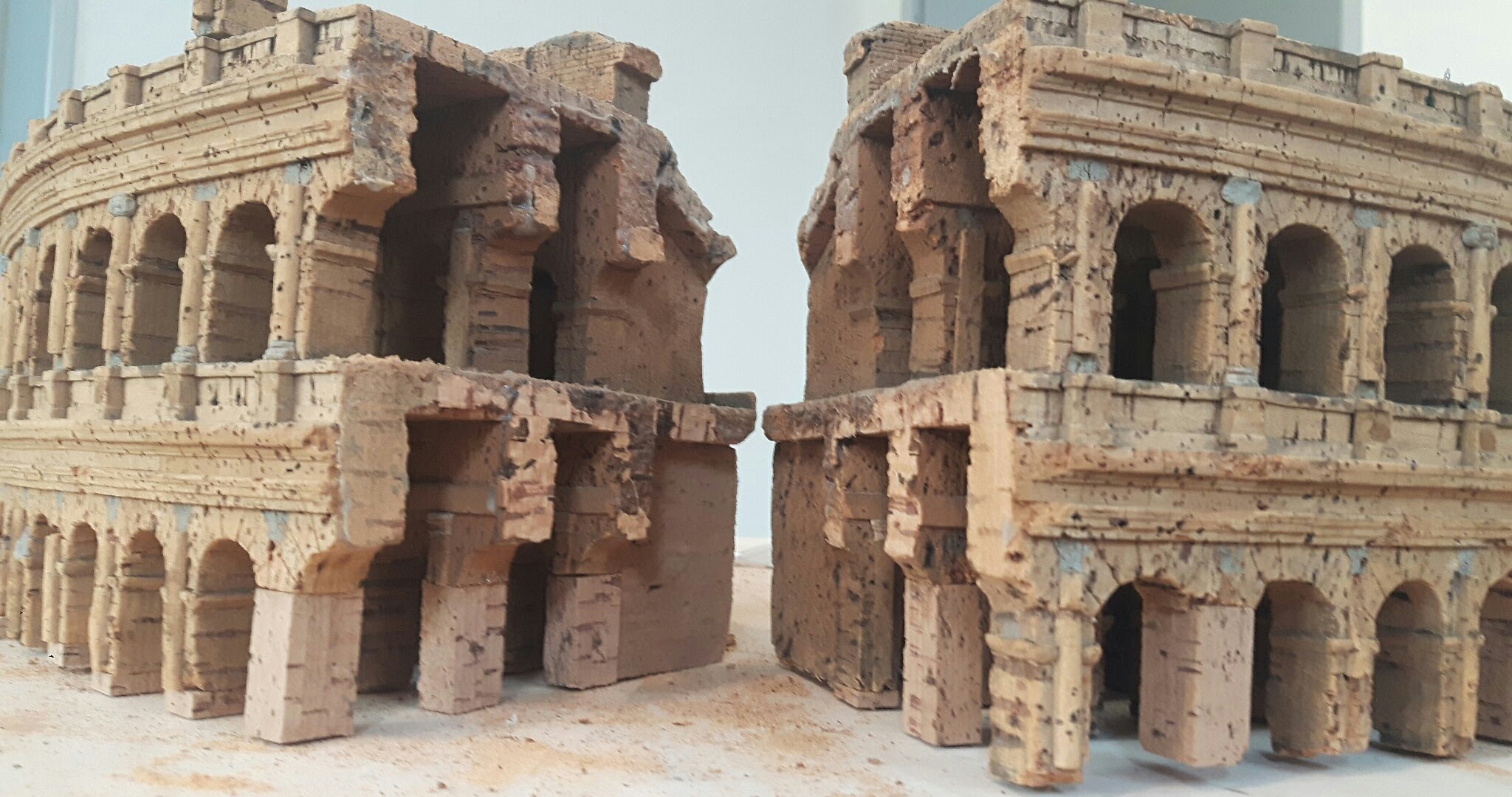


 During the centuries the model was badly treated and broken parts where fitted incorrectly with the wrong glue. Dieter has to cut through the whole structure and work like a surgeon to stabilize the fragile cork and heal the wounded sections…
During the centuries the model was badly treated and broken parts where fitted incorrectly with the wrong glue. Dieter has to cut through the whole structure and work like a surgeon to stabilize the fragile cork and heal the wounded sections…

UPSIDE DOWN

THE WALL – A PLACE TO MEET…

ZDF – WELCOME TO JERUSALEM

PICTURES OF AN EXHIBITION

The last shots…

Best result – Thanks to the audience…
Work is nearly done…
After spending lots of energie in reconstructing the missing part of the Coliseum, work is nearly done. The last act will be to color the raw cork with natural pigments like Luigi Carotti did in his time. Inspired by a walk through the beautiful park of the Lindenau-Museum I am very optimistic to close the book as it has to be…
The Mughrabi Gate
The Mughrabi Gate is located on the north side of the Wailing Wall, directly over the Herodian-period gate known as Barclay´s Gate. Over the years the ground level outside Barclay´s Gate rose by many meters above its threshold and was finally walled up in the 10th century. Later in the 12th century a new gate called Bab al-Maghreb was installed at the level of the Temple Mount esplanade. The Gate is open until today and the only entrance to the Temple Mount for non-Muslims.
Here, Dieter Cöllen is going to create a miniature of the gate (scale 1:75) in order to integrate it later into the wall.
Cork – a forgotten material…
New Cork model of the Wailing Wall in Jerusalem in progress…
Vortrag im Lindenau Museum Altenburg
Museum Ottobeuren
Man at work


































